DIY Loudspeakers: HOME INDEX UPDATES RESPONSE WHAT'S NEW
SEAS 3-Way Classic, mkII
Copyright 2014-20 © Troels Gravesen
The drivers Crossover Cabinet Measurements Speaker-Kit
Crossover Layout Wiring The Sound
Having the ScanSpeak Discovery 3-Way Classic cabs and detachable front panels, I obviously had to do an mkII version of the SEAS 3-Way Classic. There are two things to this construction, the stepped baffle allowing a simpler crossover and better sounding speaker with improved driver integration - and the use of CA22RNY bass driver in replacement of the CA22RNX. This makes an even easier speaker to drive as sensitivity is slightly increased, some 1.5 dB (bigger magnet). Not a lot, but it all counts. Although I used the same cabinet as the ScanSpeak version I have moved the second bracing a bit as the midrange driver here is a little bigger than the ScanSpeak 10F driver. The front panel layout is tight, so make sure you have room for it all before cutting holes.
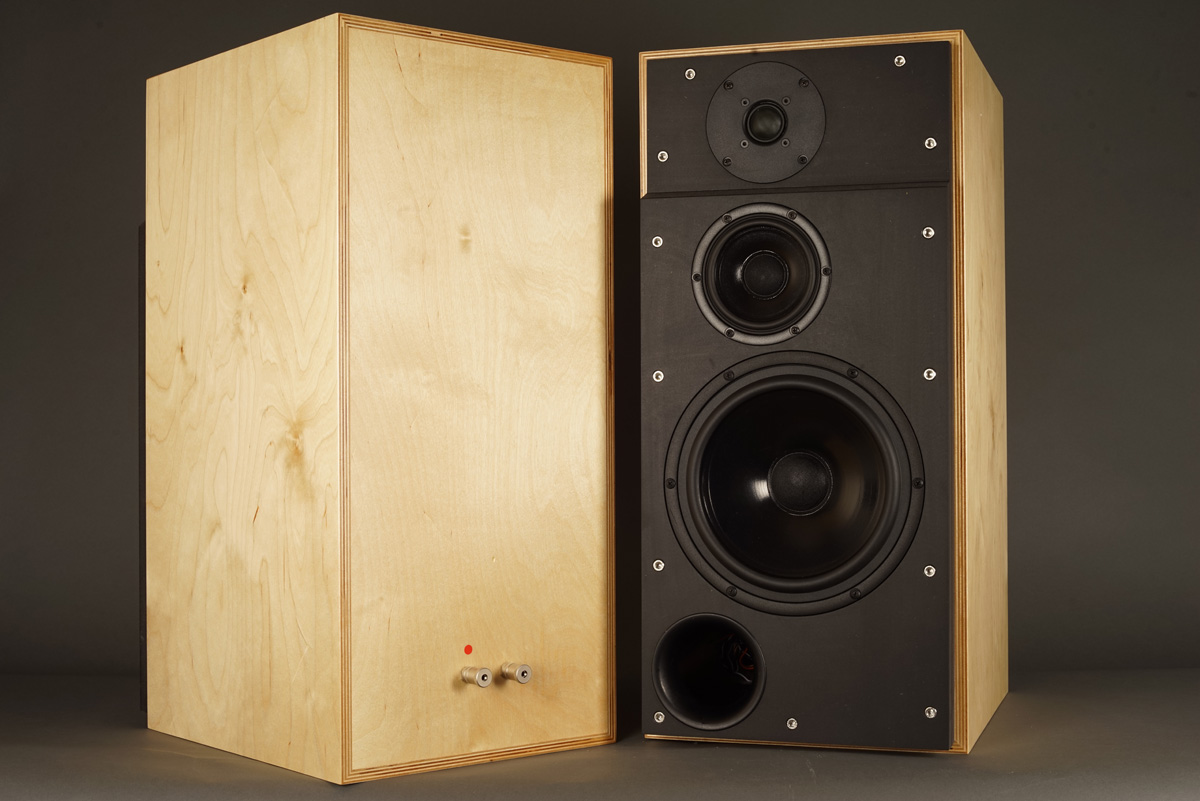
This speaker is very much related to the vintage SEAS 203 (8"bass) and 303 (10" bass) kits except for having a slightly larger midrange driver. The 203/303 featured the 10F-LG/10FM mid-drivers respectively. Having a small 3½-4" driver bridging the gap between bass and treble is a good idea. The MCA12RC is extremely broad-banded and makes crossover work easy. Obviously it costs a little more to do a 3-way, but small 3-4" drivers simply handle the 1-3 kHz range better than any 6-7-8" driver can do, and we don't have to deal with the too common ragged roll-off profile of larger drivers, although the CA22RNY here is fine up to 5 kHz with a smooth roll-off.
Listen to the SEAS Classic 3W mkII taken from my mobile phone and driven by a 10 watt EL84 tube amp here. 32 MB MOV file.
Basics:
3-way speaker from 8" bass + 4" midrange + 1" dome.
Points of crossover: 700 and 2.7 kHz, 2nd order LR2 topology.
Impedance: 8 Ohms (4 Ohms minimum at 800 Hz)
System sensitivity: 90-91 dB/2.8V, 1 meter.
Power requirements: 10 watt minimum.
Power handling: 90 watts based on bass driver long term power handling.
250 watts peak. Read
here
about power handling.
Before we move on:
1.The crossover is new and you cannot change the old design by
using the new crossover.
2. You cannot change the front panel design without needing a new
crossover and I cannot help you here, please read
here why.
3. You cannot use any other drivers than those specified.
4. Please do not ask about the sonic difference between the old one and
this new mkII - or the ScanSpeak Discovery 3W-Classic. Thanks!
Useful links (Please
follow all links before e-mailing!):
http://www.troelsgravesen.dk/tips.htm
http://www.troelsgravesen.dk/tips.htm#CONSTRUCTION_OF_CROSSOVERS
http://www.troelsgravesen.dk/crossovers.htm
http://www.troelsgravesen.dk/LCR-RC.htm
http://www.troelsgravesen.dk/Inverted-Polarity.htm
http://www.troelsgravesen.dk/choices.htm
Given the size*, this
is a speaker that might please a lot of people and annoy a few - if any!
Smooth is what is - and efficient too. With a healthy 90-91 dB
sensitivity it's 1-1½ dB more sensitive compared to the mkI - and an
easy load for even fairly low wattage tube amps. I recommend minimum
15-20 watts to get some of the dynamics. More power always means better
grip on cones and better low-end punch. My 50 wpc GlowMaster KT88 loves
it. If you never play very loud, 5-10 watts will obviously do too - in
particular PP designs having better bass grip.
The transition from bass to middriver is slightly improved from the mkI
version in rendering a closer LR2 topology and with the stepped baffle
allowing true LR2 topology for the mid/tweeter, the driver integration
is as good as can be and significantly better than the mkI version. I
simply do not notice where one stops and the other takes over unless I
beef up tweeter level by e.g. shorting R1011. My default R1011 is 2.2
ohm providing a balanced presentation of basic notes and overtones. The
slight snappiness/aggressiveness of the mkI's 2nd/3rd order mid/tweeter
crossover is gone, which is a trademark of all speakers using this
topology. As discussed during construction of the Discovery W18 speaker,
some constructors cheat a bit and implement 2nd order topology on a flat
baffle, and in a few cases it may go well (slanted baffle) but not as
good as true acoustic alignment of drivers.
I render this speaker a significant improvement over to the mkI version.
I was surprised to hear how well this speaker did from my EL84 PP tube
power amp. No, the bass punch is better from the GlowMaster, but the
midrange... very good indeed. I'd love to try the QUAD II with these
speakers.
*: Size is always an issue to consider and it takes some experience to know what 220 cm^2 of bass membrane area can do and what it cannot. An 8-inch is not a 12-15 inch bass driver with the size close to the skin of a kick-drum. The more power you add, the more the membrane must move and the more distortion it will make. Membranes should move as little as possible, hence the need for large driver to generate the desired sound levels.
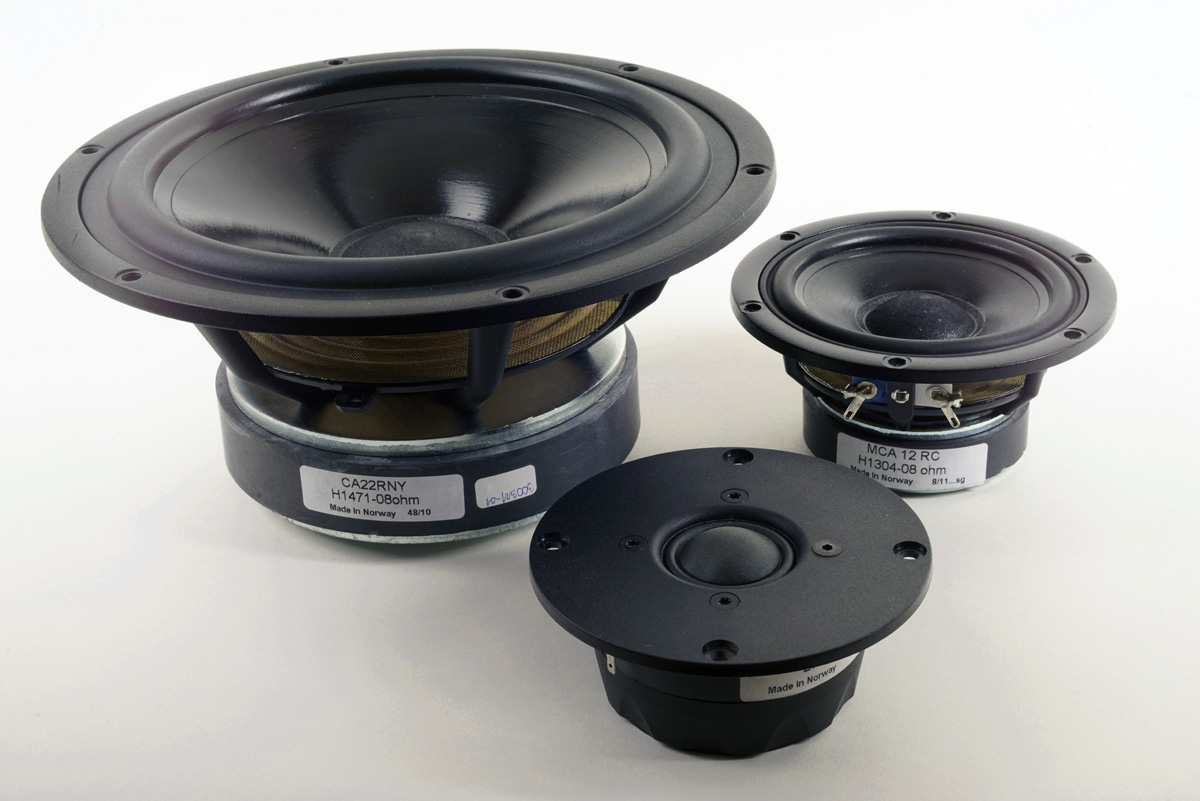
click image to view large
Download driver specs: CA22RNY MCA12RC 27TFFC

Crossover components' values come with the Kit Instructions.

Click image to view large.
Open in MSPaint and 1 pixel = 1 mm.
You cannot use a flat front panel with this design!
If so, you would need a new crossover and I
can't help.
Please read here:
http://www.troelsgravesen.dk/crossovers.htm

I recently had a very sad response to a 3WC project. This is probably
the worst thing you can do. Flat retracted front panel. The result is
the crossover doesn't work and the builder has serious diffraction
issues due to the cabinet edges. Money wasted.
As the layout of the drivers and port is very tight, mark the exact diameter of drivers and port on front panel before routing. There should be some 3-4 mm between the port and the bass driver. Pay notice the distance from top to center of drivers is 10 mm more than the distance from top of front panel.
Test midrange enclosure for tightness: Stuff the vent and push the bass driver membrane. The midrange cone should not move at all!
As the cabinets are the same as the ScanSpeak 3-Way Discovery (construction wise, not dimensions), no need to repeat all the photos here.
The black front panels are made from through-coloured MDF. This black MDF is really like HDF, high-density fiberboard, weighing some 0.84 g/cm^3 compared to 0.64 g/cm^3 for the common brown MDF, although it depends on MDF thickness. Thick MDF sheets often have a rather soft center as producers may cut production cost by reducing glue content. Black MDF has an almost ceramic feel to it and comes at approx. twice the cost of standard MDF.
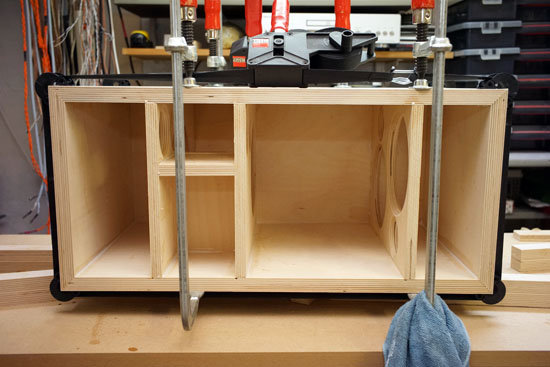

Cover internal panels with felt except front panel.
Add acoustilux to the top and bottom as seen on SBA-3WC page.
Follow link
here.
Also check out the Discovery-3WC-mkII pictures for damping tips. Follow
link
here:
Measurements may give us an idea
of tonal balance of a system, i.e. too much or too little energy in
certain areas. Measurements may tell us about bass extension if
far-field measurements are merged with near-field measurements. In
addition to this ports may contribute to bass extension. Most of us
diy'ers do not have access to an anechoic room for full-range
measurements from 20-20000 Hz.
What cannot be seen is what kind of bass performance we get in a given
room. Bass performance is highly dependent on in-room placement of your
speaker and the same speaker can be boomy in one place and lean in
another. Actual SPL level at 1 meter distance and 2.8V input is useful
for en estimate of system sensitivity and combined with the impedance
profile may give an idea of how powerful an amplifier is needed to drive
the speaker to adequate levels.
What measurements do not tell is the very sound of the speaker unless
displaying serious linear distortion. The level of transparency, the
ability to resolve micro-details, the "speed" of the bass, etc., cannot
be derived from these data. Distortion measurements rarely tell anything
unless seriously bad and most modern drivers display low distortion
within their specified operating range.
Many people put way too much into these graphs and my comments here are
only meant as warning against over-interpretation. There are way more to
good sound than what can be extracted from a few graphs. Every graph
needs interpretation in terms of what it means sonically and how it
impacts our choice of mating drivers, cabinet and crossover design.
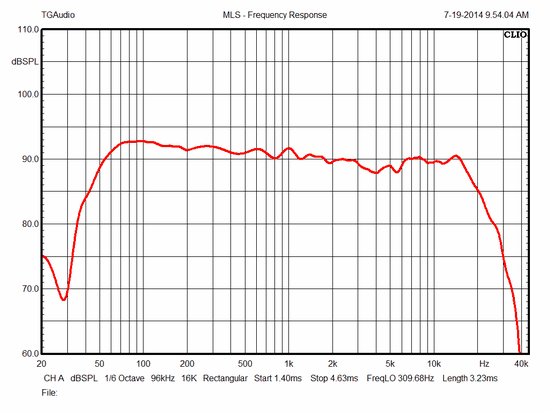

Left: SPL from speaker at 2.8 Volts input and normalised for 1 meter
distance.
Speaker sensitivity = 90-91 dB/2.8V. Reading merged with bass nearfield
response at 200 Hz.
Right: System impedance (red). Thus is basically an 8 ohms speaker with
a minimum of 5 Ohms. Green is electrical phase.
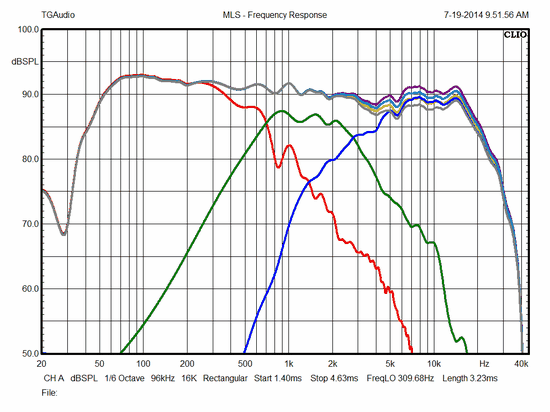

Left: SPL from drivers driven from crossover and summed response with
various tweeter attenuation resistors (R1011), 1.0, 1.5, 2.2 and 2.7
Ohms.
Points of crossover is 700 Hz and 2.8 kHz.
Right: Close-up of tweeter attenuation. With R1011 = 1.5 ohm we have
fairly flat response. My default is 2R7 making a better balance of mids
and highs, but take your pick and find what you like the most. 1R5 will
follow the kit in case you want it really hot.

Crossover components' values to come with the kit.
Two options available with either Superior-Z (shown above) or Standard-Z for midrange and tweeter.
You can buy the kit with or without the drivers - or
some of the drivers if you already have some.
Please ask Jantzen Audio
for options.
All kit and component prices may be subject to change and are always to be confirmed by Jantzen Audio Denmark.
Download Complete Kit Sale Presentations here:

All technical questions to troels.gravesen@hotmail.com
All questions regarding purchase of kits, please mail Jantzen Audio at contact@jantzen-audio.com

Connect A to B with wire.
Connect either R1011a or R1011b to C1021 (tweeter attenuation).







